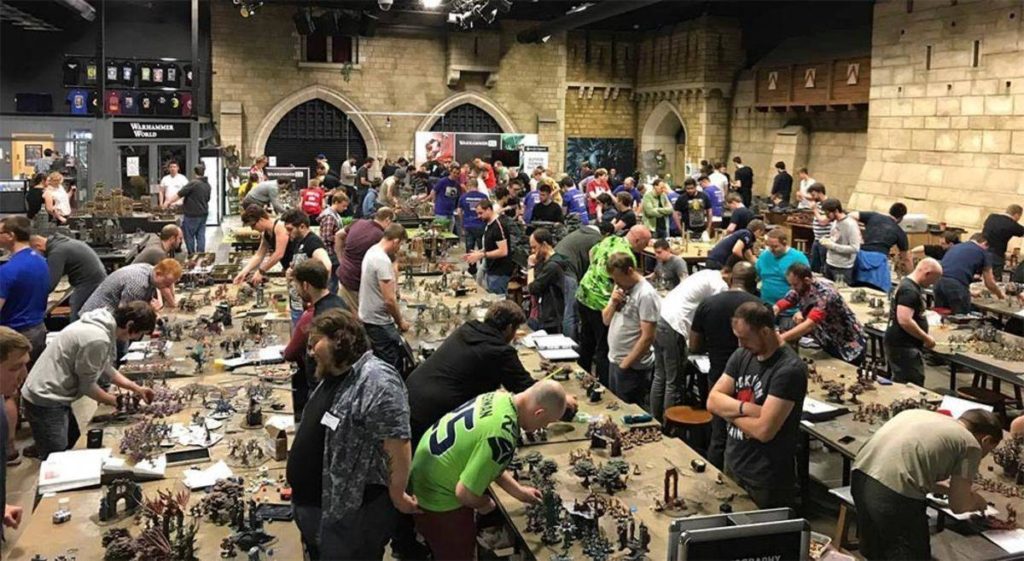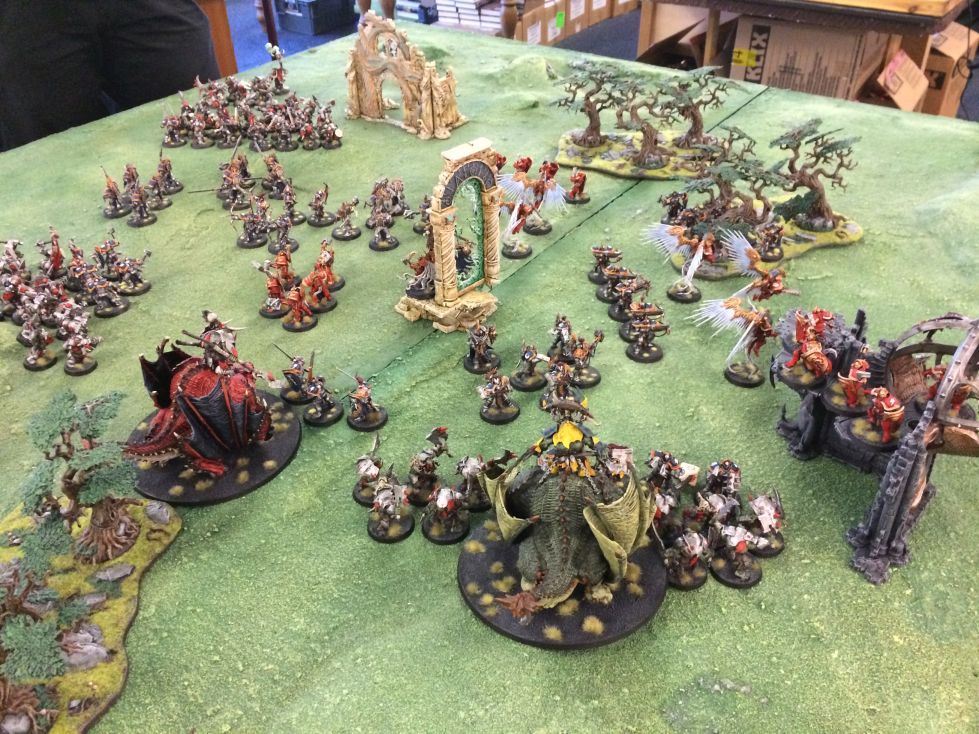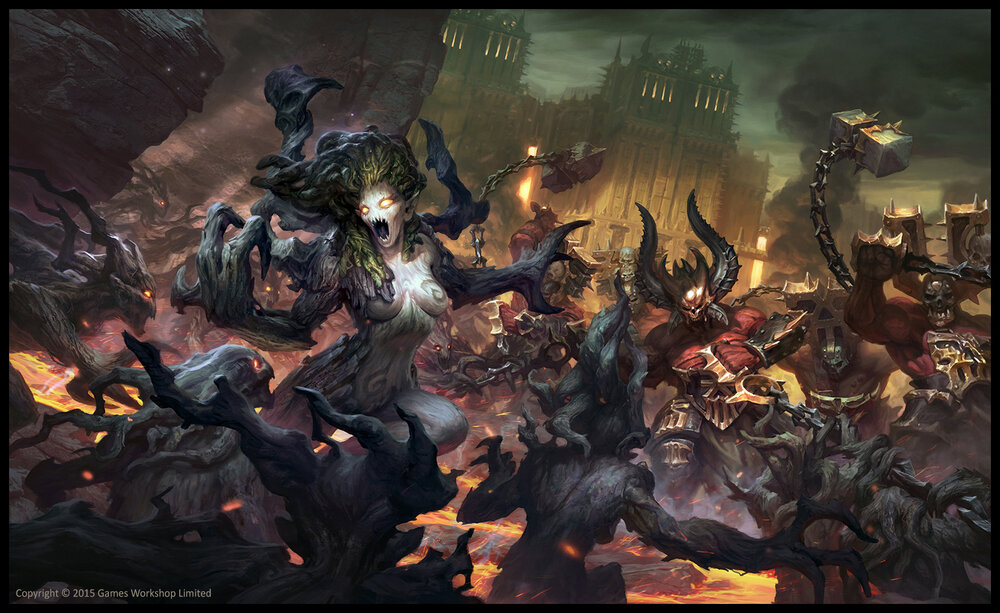With serious competitive Age of Sigmar growing quickly, we take a look at the game, its growing popularity, and what makes it worth playing.
It isn’t a secret to readers of my articles, that I love competitive table-top wargaming, but also approach it with the belief that it can be rewarding to more than just those who chase the top-table exclusively, with a revolving door of armies. It is with that in mind that I have to say I just love Age of Sigmar as a serious, competitive, system. Sure it has its boogymen armies (more of those later), but it also has a shockingly diverse meta beyond those outliers, and those armies offer something really special… uniqueness.
Before we dive more deeply though, allow me an ultra-condensed timeline of Age of Sigmar. At launch, AoS was table-top’s wild west… a lawless place without points, with rules that would give buffs to players with the most glorious mustache (no, that isn’t a joke). I recall being laughed out of a venue when I offered to run a comp’d event, and while fun over a few drinks with friends, to say it was a non-factor competitively, would not be an understatement.
The release of the General’s Handbook (now a yearly place to address rebalances, shore up mission quality, etc) rescued the game by adding points, and slowly working to remove sheer comedy based rules.

Flash-forward further still, and we are now three battletomes (read: codex for our 40k readers) away from a FULLY updated 2nd Edition. With other additions in the form of Endless Spells, faction terrain, and more, Age of Sigmar has matured and evolved into a rock-solid game both familiar and unique to 40k.
The result is a game that took some time for tournament organizers to notice. I can’t begrudge anyone for not keeping up with a game that didn’t necessarily make the best of first impressions, but word of mouth has a way of getting around. 2019 feels as if it has been the critical-mass year for the competitive scene, however. More than 75 ranked, GT or larger events have been held this year, around the world! That number has grown year-over-year, and is helped in large part by an incredibly dedicated, fanbase, that in my experience is among the most fun groups of gamers I have interacted with.

So what is it about Age of Sigmar that makes it more than Warhammer 40k’s high-fantasy cousin? Some of those answers are obvious, and others are surprisingly subtle. I will be devoting articles in the near future to elaborate on these next points in greater detail, but here are some broad strokes.
- Wildly different army mechanics: To a far greater extent than 40k, you can really feel the long leash afforded to AoS battletome designers. Rather than a small army specific buff, most AoS armies have a handful of significantly unique mechanics. Nurgle literally have a plague-cycle which featured various buffs depending on the turn, as well as ways of spreading (and rewarding you for it) the very idea of Nurgle’s Rot. The Legions of Nagash raise the dead from previously set up grave-sites. Khorne collects blood from the deaths of enemies OR friends to power a blood tithe. Each army generally does something characterful that already informs a unique playstyle before you have even created a list. Likewise, the manipulation of your army-specific mechanism provides another layer for clever designers to play with when creating individual units, as well. Armies feeling soooo different has really made me feel curious about every single release.

- Movement is king: While one could casually assume AoS is to melee, what 40k is to shooting (and not be wrong per se), it is actually the movement phase where competitive AoS really happens. This is an awesome, albeit subtle throwback to its Warhammer Fantasy parentage, but to succeed in AoS is to play a game of thoughtful positioning. Even the humble charge or pile-in (with subtly different rules from 40k) reward skill from a player. Carefully considering not only what to pull into combat, but how much to pile-in or deny enemy pile-in, can make or break games, and a ruthless unit coherency rule makes it possibly to put opponents in really bad spots. Perhaps best of all is the realization on the designer’s part, that this is the case, as all competitive missions (which just keep improving), really hinge as much on ideas such as table presence, and board-control, as they do removing opposed models.

- Spells can be real, tangible things: With the edition of Endless Spells, AoS saw a really fun, but also meaningful addition. A pool of largely universal spells is available to most armies, coupled with army specific ones as well. When cast these take the form of models physically on the table, representing iconic (or infamous for Old-World Ogre players such as myself) forces such as The Purple Sun of Shyish. These all provide value beyond their individual abilities as they become road-blocks to impede enemy movement, ways to snipe otherwise difficult to pick-out support pieces, and more. A big part of why they have helped craft a largely stronger competitive game, however, comes from the fact that nearly any army can benefit from them. This can be a great equalizer, and I suspect is one of the low-key forces at work keeping the game balanced outside of a couple aforementioned books.

Now, before I wind down this brief introduction to competitive AoS, I have to address an entirely valid sticking point. It would be naive to suggest the game’s balance is perfect. Arguably, the game’s greatest strength, its wildly diverse mechanics from one army to the next, can also be its weakness at times. If every game aspires to a 50% win-rate for every single faction, it becomes obvious that the Hedonites of Slaanesh sitting on a 76% win-rate is well outside of acceptable. That said, the twice a year rebalance passes the game receives have generally fixed the extreme cases of imbalance, and mercifully problems at this level have been rare. To their further credit, that vast majority of the armies are sitting at +/- 5% of 50% which actually speaks to very solid balance beyond a couple of books.
One last point, regarding balance, and something unique that I have observed in the AoS community. I have noticed that hardcore fans recognize any army at a GT capable of going 4/1 as being solid, and this mentality really comes across as the healthiest of competitive mind-sets. There can only ever be one winner at an event, but, as I always profess as a believer in semi-hardcore competition, there can be many people that do well while taking whatever it is that they love. For what it is worth, in 2019, nearly every single army has had at least one 4/1 GT showing.
If you are still reading this, I want to thank you for indulging me in my Competitive AoS primer. If you had been on the fence, or curious, I hope I have piqued your interest in maybe taking your AoS experience to a next level. I authentically, gleefully, love a game system where you can fall in love with really specific models, or a really oddball mechanics, but also have the confidence that you may be able to put in a good tournament showing as well.
Starting next week we will begin taking deep, looks at specific armies competitive play, as well as general ways to elevate your skills and make the most of the places where 40k and AoS differ. I have a whole lot of armies to get through, but if you would like to see anything in particular, drop a comment below and I will see what I can do.
And remember, Frontline Gaming sells gaming products at a discount, every day in their webcart!




Now that ogor mawtribes (ogre kingdom) is back together, I’m getting back in the game. Hopefully competitively next year. Please do ogors early in the order
While I haven’t been using them recently, I own loads of Ogres, so that is definitely happening. Their shocking, top-table performance at Kriglustan a few weeks ago really opened some eyes.
When they take random turn order out of the game, I’ll consider it. But “oops your opponent got to go twice and just sort of annihilated 1/3 or 1/2 your army and there was nothing you could do about it other than roll better” is a pretty bad feeling. And the AoS community is weirdly defensive of this failing in the rules.
Same here. It’s the strangest part of the rule in that it’s easy to fix, and people don’t.
I understand both sides on this one. Knowing it is a possibility really should be taken into account in deployment, movement, and list building. It isn’t my favorite aspect of the game, but working with it in mind certainly is part of the game’s character.
I’ve heard the “take it into account” argument before, but to be honest I don’t really buy it. To illustrate why, let’s imagine a slightly different game scenario for a second.
Envision a game that is exactly like AoS, except that at the end of each turn you roll a d6 and on a 6, you immediately take another turn; if you roll hot, there’s no limit to the number of turns you can take in a row. Now, obviously getting to take an extra turn is not just an advantage, but a nigh-insurmountable advantage- if you have managed to luck out and roll two “extra” turns total over the course of a game, you are going to be hard-pressed to lose it.
That game, and that mechanic, are clearly broken. They don’t add to the fun or strategy of the game- the effect is random and not controllable. Moreover, while you can take actions in the knowledge that it is a possibility, you can’t rely _plan_ on it and its existence in the game doesn’t realistically add any kind of strategic depth to the game- it just makes it so that there is a random chance one player will be at a significant advantage.
I think that all of those same arguments apply to random turn order as well. It isn’t fun, ever. It isn’t strategic, because while you can play with its potential in mind it really is just a random thing that can happen to you that you don’t really have a way to prevent. (You can’t “play around” the enemy getting more actions and more movement than you in a useful way- because if you could, that would be indicative that action and movement economy in the game were fundamentally asymmetrical, which AoS simply does not have the rules depth to support.) And it doesn’t even really have a cost- it’s just a thing that can happen in certain situations that one player has no way of preventing.
Now, that’s not to say that other GW games don’t also have some bad mechanics in them- 40K’s “I go you go” system is severely flawed and I think would be better off being retired and points values in the game have bloated to the point of being near unsustainability. But those flaws shouldn’t be arguments _for_ the flaws in other game systems, and I think that random turn order is sufficiently discouraging to players who want a game where randomness is not an ever-looming factor to such an overwhelming degree that it really strikes hard against AoS. I hope they fix that in a coming update to the game, because it otherwise does a lot of stuff really well and is really fun, but “I rolled a 4 and you rolled a 3 therefore I get to take two full turns unimpeded” is just tremendously bad design.
I find that the AoS community is very defensive of their game in general, way more than 40k is. Mind you, after years of getting shat on for the atrocious beginning and lingering resentment over End Times I can’t say I blame them.
I think unfortunately this is a hill that GW will die on. The new Chaos book has an HQ that you roll the next turn dice in secret! So you know if you get the double turn and can plan around that.
That is a game breaking rule I my opinion, on top of the domination of a single army for most of the year. When if you take out the mirror matches they hit over 80% win rate I don’t find AOS to that enticing.
I will say that the painting and just model design are on another level. I think that is what GW wants for AOS, crazy models that have crazy rules that can not and should not be taken seriously.
Which is fine. It gives AoS a unique flair and character and caters to the preferences of the audience (much like 40K’s IGO-UGO system)
Like 40K, GW’s big games aren’t primarily made for competitive play first and foremost (which doesn’t mean you cannot play them competitively, if you so choose).
But if you want a (Games Workshop) game that dispenses with some of those mechanics in favour of a design that is, from the ground up, explicitly more competitively tuned with less RNG-mechanics, etc.. there is always Shadespire or Kill Team Arena (not to mention X-Wing, Infinity, Warmachine, etc..).
Not every game a company makes has the same (main) audience in mind. WoTC makes MtG, but they also make D&D, etc.. Different priorities apply and some mechanics will be more suitable to one game and less for another. And if you insist on being the “competitive D&D” player instead of just playing MtG, you might need to tweak the rules a bit.
Also, let’s be clear : it’s as much “the game character” than the bonus for Empire army if you had a mustache.
AoS (and arguably all the GW games, but especially AoS) wasn’t made for competitive. At all. The initial edition had gone *ridiculously* far to be non-competitive, and they made effort to just make it unfriendly to it instead of the initial mess.
Now, organizing big tournaments of a non competitive game can be fun. People can have plenty fun encountering random opponents and seeing where the dice go. But it’s more “why you should try AoS tournament” than trying the sort-of oxymoron who is “competitive AoS”.
AoS works fine competitively, actually. I’ve been to lots of AoS tournaments, they’re fun. The double turn does turn people away, but it really isn’t as big of a deal as it af first appears when you get used to it. You just have to plan for it. However, I do think it inhibits the game’s growth as I’ve seen it turn so many people away the first time they try it.
Great article.
I am intrigued.
I would love to have an article(s) giving a brief explanation of how the different armies play styles are and how to play them or something.something good for newbs and intermediate players. I want to start AoS, but don’t know where to start. I love so many model ranges I can’t just pick that way.
You’ll be getting exactly that. I have the first of the army analysis articles in the works right now, and more will be coming every week!
I too am intrigued. Your plan is a good one and should be comtinued.